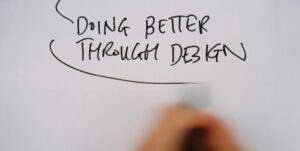In a world where rapid consumption and disposability are increasingly impacting our daily lives, the importance of circular design has never been more profound.
Circular design is more than just a trend—it’s a necessary response to the environmental challenges we face today. Sibley Grove’s impact extends beyond the confines of interior design, serving as a compelling example of how thoughtful design can drive positive social and environmental change.
So why should businesses and individuals alike embrace circular design? How does it benefit both the environment and our own lives? In this article we will delve into the significance of circular design and explore how it can shape a more sustainable future for all.
The Challenges of Linear Design
To truly understand the importance of circular design, we must first acknowledge the flaws of the linear design model that has dominated our society for decades. This traditional approach to manufacturing and consumption is based on a ‘take-make-waste’ mentality, where resources are extracted, transformed into products, and ultimately disposed of in landfills or incinerators. This linear system not only depletes natural resources at an alarming rate but also generates vast amounts of waste and pollution.
Why Does Circular Design Matter?
By implementing the principles of circular design, designers can find ways to repurpose and reuse materials, reducing the need for new resources and minimising waste. This not only has a positive impact on the environment but also economic benefits. With resources becoming scarcer and more expensive, circular design can help lower costs by making use of existing materials instead of constantly sourcing new ones.
Circular design also promotes longevity and durability in design. By using high-quality materials that can be easily maintained and repaired, designers can create spaces that are built to last. This not only reduces waste but also contributes to a more sustainable future by reducing the need for constant replacements or renovations.
What are the Principles of a Circular Economy?
The principles of a circular economy can be encapsulated within three key tenets:
Preserve and Enhance Natural Capital
This advocates for the prioritisation of regenerative resources and ensuring continuous flow in cycles. Minimising the use of finite resources and reducing the system’s dependence on them is crucial.
Optimise Resource Yields
This involves creating a system that allows for the highest possible utility of products, components, and materials through their lifecycle. It means designing for durability, reuse, remanufacturing, and recycling to ensure continuous usage of items, and making certain they are not discarded after a single-use.
Foster System Effectiveness
This principle aims to eliminate negative externalities such as emissions, waste, and pollution, while also taking into account the impact on society by managing labour practices, consumer protection, and health and safety. It also focuses on the efficient use of water, energy and other key resources.
Material Health aligns with the first principle of the circular economy, which is to Preserve and Enhance Natural Capital. It focuses on ensuring that the ingredients used in products are safe for human and ecological health, thus preserving our natural resources.
Material Reutilisation embodies the second tenet of the circular economy, which is to Optimise Resource Yields. This principle encourages the design of products in a way that allows their constituent materials to be disassembled and reused, promoting sustained material utility.
Renewable Energy Use and Water Stewardship reflect the third principle of Fostering System Effectiveness. These categories evaluate the energy and water efficiency of manufacturing processes, advocating for resource optimisation, waste reduction, and minimising negative impacts on society and the environment.
Social Fairness considers the social aspects of the circular economy, emphasising fair and ethical treatment throughout the production process. This includes labour practices, consumer protection and health and safety, contributing to a more inclusive and sustainable economy.
By embracing the circular economy principles, industries move towards a more sustainable, inclusive, and effective future, guided by the comprehensive approach of the ‘Cradle to Cradle’ certification.
The Synergy of Circular Economy and Circular Design
The circular economy and circular design are intrinsically linked, working together to redefine products and services to mitigate waste and negative impacts on the environment.
Circular Design, as a key principle of a circular economy, exemplifies the manifestation of circular thinking in tangible objects and spaces. It applies the principles of circular economy – preservation of natural capital, optimisation of resource yields and fostering system effectiveness – in the design process.
This harmonious integration of circular economy and circular design results in products and services that are sustainable, waste-free and mindful of the environment. It allows designers to create while also ensuring that the resources used today are available for future generations.
In essence, circular economy provides the theoretical framework, and circular design principles brings this theory to life. By working hand in hand, they pave the way for a future that is both environmentally and economically sustainable.
What Lies Ahead for Circular Design?
The next decade is poised to see an exponential rise in the adoption of circular design principles across all sectors. As the world grapples with pressing environmental challenges, circular design is expected to transition from being an optional strategy to a core business requirement. We can anticipate increased regulatory support for sustainable practices, with stricter waste management policies and incentives for businesses that adopt circular models.
Advancements in technology like 3D printing and AI will empower designers to explore new ways to repurpose and reuse materials. As the understanding and appreciation for circular design grow, we can expect a shift in consumer behaviour, with an increasing demand for sustainably designed products and spaces.
We envisage a stronger focus on social aspects within the circular economy, emphasising the importance of inclusivity and accessibility in design. Meeting these expectations will require innovative, forward-thinking approaches that disrupt conventional design paradigms. In essence, the future of circular design is one of immense potential and transformation. It holds the promise of a more sustainable, inclusive and resilient world, and it is up to us to seize the opportunities it offers.
The circular economy, when paired with principles of circular design, forms an essential blueprint for sustainable and responsible development. As we venture further into the 21st century, these concepts are no longer just optional strategies, but have become paramount to our collective survival and prosperity. They challenge traditional norms and compel us to innovate and optimise, to preserve our finite resources and ensure the health of our planet.
As we have seen, the circular economy is rooted in three core principles: preserving and enhancing natural capital, optimising resource yields, and fostering system effectiveness. These principles, when applied through circular design, result in products and spaces that are not just efficient and sustainable, but also ensure social fairness and inclusivity. This is a significant shift from the linear model of ‘take, make, dispose’ to a more sustainable approach where waste is viewed not as an end, but as a new beginning. It is clear that the vision for a circular future is ambitious, but it is also very achievable.
Advancements in technology, shifts in consumer behaviour, and stricter regulatory support are all converging to facilitate this transition. With the rise of technologies like 3D printing, artificial intelligence, and the Internet of Things, we have the tools necessary to drive this change.
While the road ahead is challenging, the rewards are manifold. A world where waste is minimised, resources are optimised, and society is fair and inclusive is a world that is truly sustainable. It is a world that is resilient and prepared to face the uncertainties of the future. It is a world that we can proudly pass on to the generations that follow.
The circular economy and circular design thus offer not just an alternative, but a fundamental shift in mindset. They prompt us to rethink how we produce and consume, and to redefine our relationship with the environment. In doing so, we have an opportunity to create a future that is not just sustainable and inclusive, but also resilient and vibrant.
Let us then seize this opportunity and pledge to make circularity the norm rather than the exception. For in the end, our survival and prosperity depend on it.




